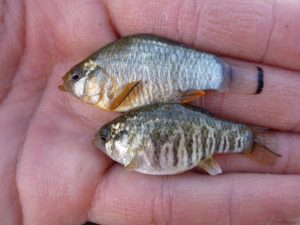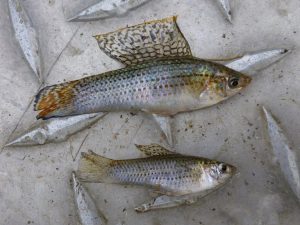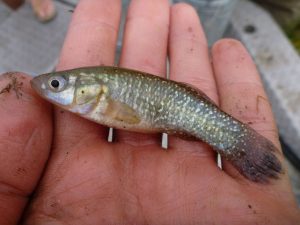Study Finds Different Avoidance Behaviors in Estuarine Fish to Oiled Sediment
– OCTOBER 5, 2017
A Louisiana State University researcher conducted laboratory experiments to learn how estuarine fish behave around sediments containing varying concentrations of weathered and fresh oil. He observed that fish exhibited a stronger avoidance response to medium and high concentrations of fresh oil compared to low concentrations and observed no significant avoidance of any weathered oil concentrations. The fishes’ behavior may have lessened their exposure to compounds associated with the Deepwater Horizon spill and may have offered some resilience to negative effects. The researcher published his findings in Marine Ecology Progress Series: Avoidance of oil contaminated sediments by estuarine fishes.
Studies on oil spill impacts on coastal fishes have produced complex results, with laboratory experiments indicating negative effects on fish physiology yet field assessments often identifying few impacts to abundance and biomass. One explanation for this discrepancy is that organisms that can move may avoid oil, which was very patchily distributed. This study used Gulf killifish, sheepshead minnow, and sailfin molly (indicator species that are important to the marsh food web as predators and prey) to examine their potential to detect and avoid oil.
The researcher used BP surrogate oil and sediment from unoiled marsh areas to create habitats in which fish could swim. A 38-liter tank had one end with sediment containing low, medium, or high concentrations (10, 20, and 40 ml oil 1-1 of sediment) of fresh oil (consistent with oiling found in field studies Turner et al, 2014 and Turner et al, 2014) or artificially weathered oil and the other end had sediment with no oil treatment. Fish swam for ten-minute trials during which time the researcher documented their movement and time spent in the two ends of the tank.
All three species exhibited strong responses to high and medium concentrations of fresh oil. Response to low concentrations of fresh oil varied between species, with killifish displaying significant avoidance of low concentrations of fresh oil and sheepshead minnow exhibiting moderate avoidance. Sailfin molly did not have a significant response to low concentrations of fresh oil. None of the species displayed changed behavior patterns in the presence of weathered oil.
Study author Charles Martin discussed the fish’s response to weathered oil, “This is very important because weathering began as soon as oil came out of the pipe at depth, and by the time it reached inshore areas much of the oil had degraded considerably from wave action, ultraviolet light, and other factors. As oil weathers, the most toxic chemicals precipitate and are lost.” He suggested that weathered oil may not be as toxic to these fish and that weathering may remove the toxic compounds that cue avoidance behavior. An exception to this is that oil protected from weathering in the center of tarballs or buried in the sediment may reach inshore areas as fresh, unweathered oil.
Martin recommended that future studies focus on isolating individual oil compounds that may trigger the observed avoidance behaviors and assess the sublethal effects of weathered oil (growth, reproduction, foraging). He also cautioned that experiments should use an appropriate amount of weathering that is indicative of actual exposure levels to their model ecosystem.
Data are publicly available through the Gulf of Mexico Research Initiative Information & Data Cooperative (GRIIDC) at doi:10.7266/N7NV9G95.
************
This research was made possible in part by a grant from the Gulf of Mexico Research Initiative (GoMRI) to the Coastal Waters Consortium II (CWC II).
The Gulf of Mexico Research Initiative (GoMRI) is a 10-year independent research program established to study the effect, and the potential associated impact, of hydrocarbon releases on the environment and public health, as well as to develop improved spill mitigation, oil detection, characterization and remediation technologies. An independent and academic 20-member Research Board makes the funding and research direction decisions to ensure the intellectual quality, effectiveness and academic independence of the GoMRI research. All research data, findings and publications will be made publicly available. The program was established through a $500 million financial commitment from BP. For more information, visit https://gulfresearchinitiative.org/.
© Copyright 2010-2017 Gulf of Mexico Research Initiative (GoMRI) – All Rights Reserved. Redistribution is encouraged with acknowledgement to the Gulf of Mexico Research Initiative (GoMRI). Please credit images and/or videos as done in each article. Questions? Contact web-content editor Nilde “Maggie” Dannreuther, Northern Gulf Institute, Mississippi State University (maggied@ngi.msstate.edu).








